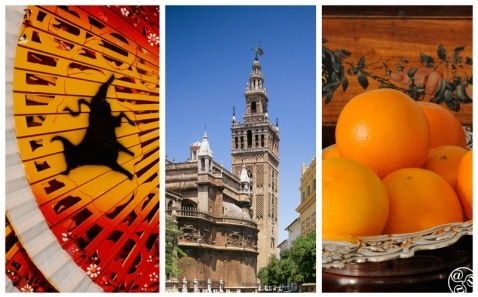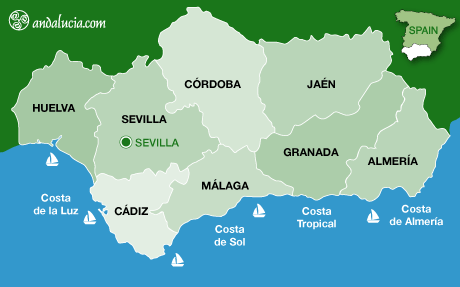
Seville is a joyous city |
|
Seville CITY GUIDE
According to legend, Sevilla was founded by Hercules and its origins are linked with the Tartessian civilisation.
Called Hispalis under the Romans and Isbiliya by the Moors, the high point in its history was following the discovery of America in 1492, when wealth flooded in from the "New World".
For all its important monuments and fascinating history, Sevilla is universally famous for being a joyous town. While the Sevillians are known for their wit and sparkle, the city itself is striking for its vitality. It is the largest town in Southern Spain, the city of Carmen, Don Juan and Figaro.
Hotels
Reviews of 20 of most the prestigious hotels of Seville. Hotels in Seville come in all shapes and sizes. There are plenty of rooms all over the centre. High season is March and April. During… More →
Hotels in Seville come in all shapes and sizes. There are plenty of rooms all over the centre. High season is March and April. During Semana Santa and the April Feria you should book even for… More →
There are several hotels located almost within touching distance of the famous Seville Alcazar Palace (Reales Alcázares de Sevilla). A lot of them feature spectacular roof terraces offering… More →
More
Seville is often referred to as the 'Jewel of Andalucia' and it's easy to see why; be it for business or for pleasure the city has such a lot to offer with its rich and colourful mix of history… More →
Sevilla or Seville is the capital of Andalucia and architecturally it's often referred to as the jewel in the Andalucian crown. With its magnificent Baroque cathedral, a Moorish Royal Palace, (… More →
If you're visiting for more than a few days then you might be interested in getting to know the surrounding area as well. With world class destinations like Cordoba and Granada (the home of the… More →
Andalucia is justifiably famous for its excellent gastronomic scene. Using first-class ingredients grown throughout the region and caught along its extensive coastline, such as jamon iberico,… More →
Together these three buildings form a remarkable monumental complex in the heart of Seville. The cathedral and the Alcázar - dating from the Reconquest of 1248 to the 16th century and imbued with… More →
Seville is a marvel. It’s a city of various diverse (and wildly beautiful) neighbourhoods: the narrow alleyways of the Barrio de Santa Cruz are lined with glorious old palaces and stunning plazas… More →
Main sights
The Alcázar Réal (Royal Palace) of Seville is one of the city’s most enchanting, and most popular, historic monuments. Along with the Cathedral and Archive of the Indies, it is recognised as… More →
The Atarazanas are Seville’s medieval Royal Shipyards in the Arenal district, formerly the port area. They are located about halfway between the Alcazar palace and the river, on the corner of… More →
Many of these casa palacios, or mansions, look quite ordinary from the outside - perhaps as impressive entrance arch, but nothing else to make them out. Inside, you find beautiful arcaded patios… More →
With UNESCO classing a complex of three buildings in Seville as a World Heritage Site - namely the Cathedral, Alcazar Palace, and Archive of the Indies - it's no wonder that international and… More →
There is no shortage of fun to be had in this exciting city, from theme and water parks offering a great family day out, to an evening of local food and flamenco shows. With its beautiful… More →
Icon of Seville, the magnificent Giralda was the tallest building in the city for over 800 years, dominating the skyline at 103m. Originally built in 1195 as the minaret of the Aljama mosque, it… More →
The two most important are the Museo de Bellas Artes and the Centro Andaluz de Arte Contemporaneo. One of the most prestigious of all Spain's Fine Arts Museums, the beautiful Museo de Bellas Artes… More →
The Museo de Artes y Costumbres Populares is devoted to a more general tradition of arts and culture. The archaeological museum covers a period dating back to Paleolithic times, while the Casa de… More →
Known locally as Las Setas (the Mushrooms), due to its short stems and wide caps, this is the most ambitious, expensive and controversial urban project in Seville since Expo 92. Opened in 2011,… More →
The cathedral's construction lasted over a century, from 1401 to 1506. It is said that when the plans were drawn up, church elders stated, "Hagamos una iglesia tan hermosa y tan grandiosa que los… More →
Seville has some of the most beautiful city parks in Europe, the Parque de Maria Luisa and the Plaza de España, as well as numerous plazas and open spaces where you can happily people watch for… More →
Other
Eating out is a way of life in Seville, whether in a smart contemporary restaurant serving innovative modern dishes, or a more traditional tiled establishment offering carillada and fried fishj.… More →
As the capital of Andalucia, Seville has a wealth of history, culture and gastronomy to offer. From Roman and Moorish delights to contemporary architecture and interactive museums, you'll have… More →
We bring you ten interesting titbits about the Andalucian capital, whether you´re visiting Seville for the first time, you´re already a seasoned expert, or you live here. Find out more about film… More →
Going out for afternoon coffee has always been part of the culture here, and cakes have steadily improved in quality over recent years. In such a warm climate, ice-cream is also popular. Menus… More →
Sevilla lies on the banks of the Guadalquivir and has one of the largest historic centres in Europe. Some of the main attractions are the former minaret, La Giralda, the cathedral (one of the largest in Christendom), and the Alcázar Palace, as well as Casa de Pilatos, Torre del Oro, the Town Hall, and the Archive of the Indies (where the historical records of the "discovery" of America are kept), the Fine Arts Museum (the second-largest such collection in Spain), plus numerous convents, parish churches and palaces.
The city has hosted two Expos (international exhibitions, or World Fairs), Expo 1929 and Expo 1992, and is the administrative capital of Andalucía.
The sailors' neighbourhood of Triana across the river from the main centre, La Macarena, Santa Cruz and San Bartolomé, the street of Las Sierpes, plus La Maestranza bullring, María Luisa park and the riverside walks are all classic images of Sevilla.
FESTIVALS
The Sevillians are great actors and put on an extraordinary performance at their annual Feria de Abril, a week-long party of drink, food and dance which takes place day and night in more than 1000 especially mounted tents. Men parade on their fine horses and women dance in brilliantly coloured gypsy dresses. A few weeks before is Holy Week, Semana Santa, a religious festival where hooded penitents march In long processions followed by huge baroque floats on which sit Images of the Virgin or Christ, surrounded by adoring crowds. Both spring.time events (March to late April) are well worth experiencing.
THINGS TO SEE
In Sevilla, you will want to visit the old city, with the Cathedral and the Giralda tower at its heart. (You can climb the steps inside the tower for a magnificent view of the City). Very close by are the royal Mudéjar palace known as the Alcazar with marvellous gardens and the Santa Cruz quarter, with narrowstreets, flowered balconies, richly decorated facades, hidden patios... Other sights not to be missed are, in the old city, the Casa de Pilatos, a large 16th-century mansion where Mudejar, Gothic and Renaissance styles blend harmoniously amidst exuberant patios and gardens and, crossing the Triana bridge over the Guadalquívir River, the lively quarter of Triana with charming streets around the church of Santa Ana and traditional ceramic shops.
